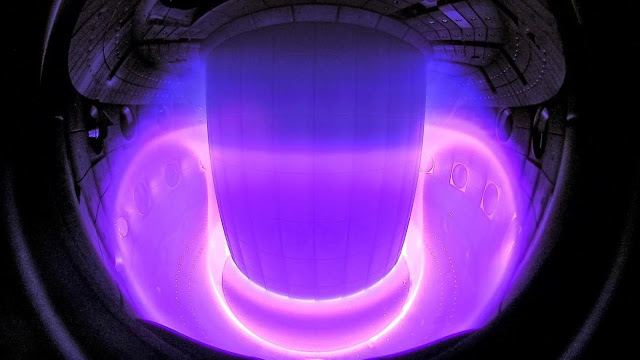EPFL - École Polytechnique Fédérale de Lausanne logo.
Feb 20, 2022
Scientists from EPFL's Swiss Plasma Center and Google's DeepMind have designed a system to better control nuclear fusion with artificial intelligence.
Image above: Plasma inside the Lausanne tokamak. Image Credits: Curdin Wüthrich/SPC/EPFL.
This is a scientific feat achieved by scientists from the Swiss Plasma Center (SPC) at EPFL and DeepMind, a British firm specializing in artificial intelligence, acquired by Google in 2014. They have developed an algorithm in able to better control nuclear fusion. Based on deep reinforcement learning AI, he was able to control a plasma (matter whose temperature reaches millions of degrees) in the tokamak (a ring-shaped facility for nuclear fusion research in which the plasma is confined by a powerful magnetic field so that it does not come into contact with the walls) of the SPC, according to a study published this week in the journal “Nature”.
Credits: DeepMind on Twitter
The AI was first trained in a simulation. Once the knowledge was acquired, she was able to “create and maintain a vast array of advanced plasma shapes and configurations, including one in which two separate plasmas are simultaneously maintained in the chamber,” which had never happened before. previously with the tokamak of the Swiss Plasma Center, explains EPFL in a press release.
Animation above: École Polytechnique Fédérale de Lausanne (EPFL)
The new plasma control method was then tested in real conditions on the Lausanne tokamak. “Our simulator is the result of more than 20 years of research and is constantly being improved,” said Federico Felici, scientist at SPC and co-author of the study. “Despite this, tedious calculations are still required to determine the correct value of each variable in the control system. This is where our joint research project with DeepMind comes in,” he added.
The collaboration between the two entities dates back to 2018. It "encourages us to improve our reinforcement learning algorithms, and ultimately it can accelerate plasma fusion research," said engineer Brendan Tracey. senior researcher at DeepMind and co-author of the study.
Production record
Landmark results from EUROfusion scientists at UKAEA’s JET facility
Last week, scientists at the Joint European Torus in the UK announced that they had produced more energy from nuclear fusion than ever before: 59 megajoules of energy in five seconds. This is one more “step” towards the production of this energy touted as clean and cheap.
Related article:
Nuclear-fusion reactor smashes energy record
https://orbiterchspacenews.blogspot.com/2022/02/nuclear-fusion-reactor-smashes-energy.html
Related links:
DeepMind: https://deepmind.com/
Swiss Plasma Center (SPC): https://www.epfl.ch/research/domains/swiss-plasma-center/
École Polytechnique Fédérale de Lausanne (EPFL): https://www.epfl.ch/en/
Joint European Torus (JET): https://www.euro-fusion.org/devices/jet/
Images (mentioned), Animation (mentioned), Video, Text, Credits: EPFL/CCFE/ATS/Orbiter.ch Aerospace/Roland Berga.
Best regards, Orbiter.ch




